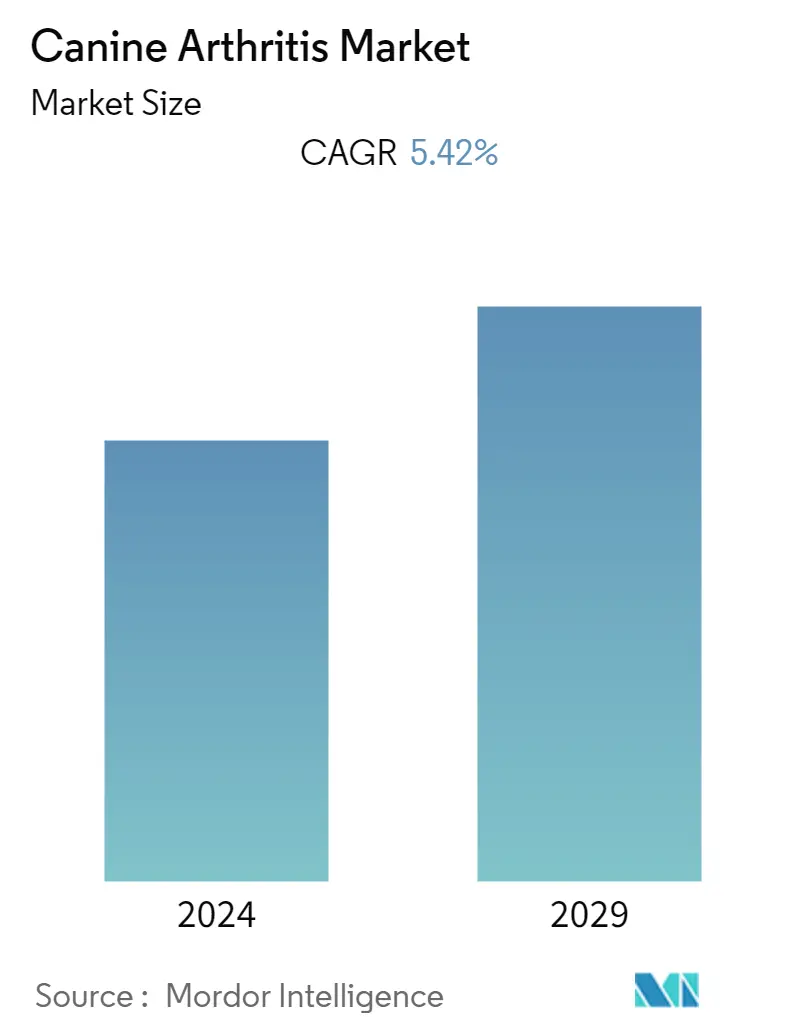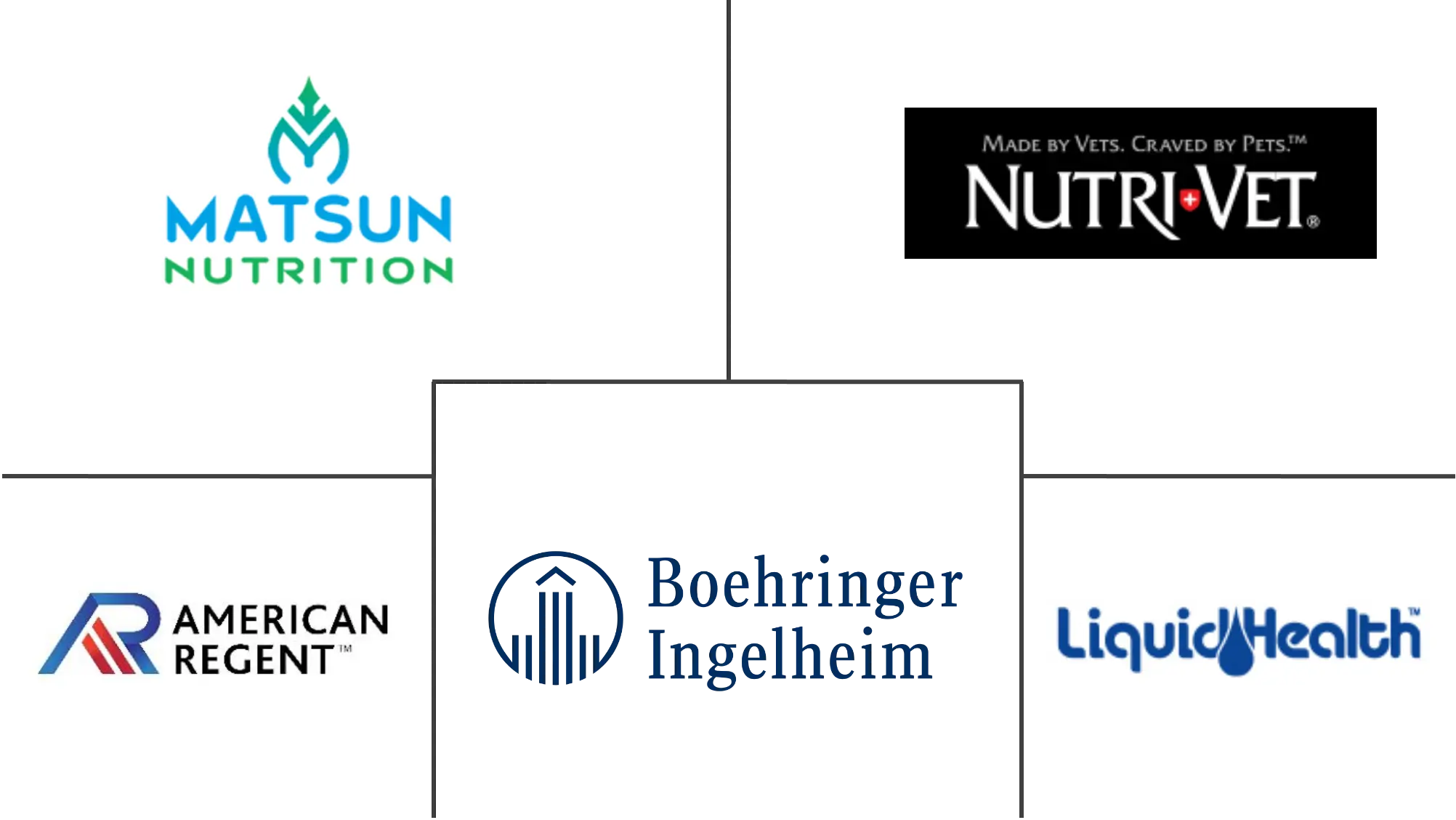Market Size of Canine Arthritis Industry

| Study Period | 2019 - 2029 |
| Base Year For Estimation | 2023 |
| CAGR | 5.42 % |
| Fastest Growing Market | Asia Pacific |
| Largest Market | North America |
| Market Concentration | Medium |
Major Players
*Disclaimer: Major Players sorted in no particular order |
Need a report that reflects how COVID-19 has impacted this market and its growth?
Canine Arthritis Market Analysis
The prevalence of obesity among the pet population is increasing all over the globe. Owing to the fact that excess fat and body weight increases the load on joints, obesity is directly associated with osteoarthritis in dogs, which results in difficulty of movement. According to the results of the 2017 Pet Obesity Survey conducted by the Association for Pet Obesity Prevention (APOP), 56% of dogs were identified as overweight (body condition score (BCS) 6-7) or obese (BCS 8-9), while in 2016, APOP classified 54% of dogs as overweight or obese, in the United States. The American Animal Hospital Association (AAHA) estimated 40-50% of dogs to be overweight, and 25% of dogs to be obese, in 2017. According to data published in a journal, namely, Frontiers in Veterinary Science, in 2017, 40.9% of dogs have been identified to be obese (BCS 7/9-9/9) in the obesogenic areas in Spain.
Thus, the rise in the prevalence of canine obesity has made it the most common nutritional health problem in dogs, which results in osteoarthritis, hence driving the growth of the market studied.
Canine Arthritis Industry Segmentation
Canine Arthritis is a degenerative joint disease in dogs, which causes inflammation of joints. This highly prevalent, non-curable, and disabling disease initially focuses on moving joints but further affects the entire body. Canine arthritis could also lead to euthanasia, owing to loss of quality of life. It involves symptoms such as limping, stiffness in movement, hunched back posture, aggression, anxiety, change in appetite, and difficulty in walking and jumping. Although the disease can affect both, cats and dogs, it is more prevalent in dogs.
| By Drug Class | |
| Anti-Inflammatory | |
| Nutraceutical Supplement | |
| Others |
| Geography | ||||||||
| ||||||||
| ||||||||
| ||||||||
| ||||||||
|
Canine Arthritis Market Size Summary
The canine arthritis treatment market is experiencing growth driven by the increasing prevalence of obesity among dogs, which is directly linked to osteoarthritis. As obesity becomes the most common nutritional health issue in dogs, it leads to joint problems, thereby boosting the demand for arthritis treatments. Nonsteroidal anti-inflammatory drugs (NSAIDs) are commonly used to manage arthritis in dogs, offering significant improvements in mobility and quality of life by reducing inflammation. The development of COX-2 selective NSAIDs has minimized side effects, although adverse reactions can still occur. Major companies like Elanco provide FDA-approved NSAIDs, such as Galliprant, which is specifically designed to treat canine osteoarthritis pain and inflammation. The effectiveness of these treatments and the availability of various brands are expected to drive healthy growth in the market.
The United States is anticipated to maintain a substantial share of the canine arthritis market due to the increasing adoption of companion animals, a rising prevalence of arthritis, and higher per capita animal healthcare expenditure. With millions of households owning pet dogs and a significant portion diagnosed with arthritis, the demand for effective treatments is strong. The veterinary healthcare industry is also evolving rapidly, with advancements in technology such as biotech, genomics, and artificial intelligence, fostering competition among major animal health companies. Strategic mergers and acquisitions, like those between Boehringer Ingelheim Animal Health and Merial, have enhanced the competitiveness of key players in the market. Companies such as Boehringer Ingelheim, Nutri-Vet, LLC, and Liquid Health Inc. are prominent in this evolving landscape.
Canine Arthritis Market Size - Table of Contents
-
1. MARKET DYNAMICS
-
1.1 Market Overview
-
1.2 Market Drivers
-
1.2.1 High Prevalence of Canine Obesity and Motion Injuries
-
1.2.2 Increase in Awareness regarding Canine Health
-
-
1.3 Market Restraints
-
1.3.1 High Cost of Treatment
-
1.3.2 Side Effects Associated with Treatment Errors
-
-
1.4 Porter's Five Force Analysis
-
1.4.1 Threat of New Entrants
-
1.4.2 Bargaining Power of Buyers/Consumers
-
1.4.3 Bargaining Power of Suppliers
-
1.4.4 Threat of Substitute Products
-
1.4.5 Intensity of Competitive Rivalry
-
-
-
2. MARKET SEGMENTATION
-
2.1 By Drug Class
-
2.1.1 Anti-Inflammatory
-
2.1.2 Nutraceutical Supplement
-
2.1.3 Others
-
-
2.2 Geography
-
2.2.1 North America
-
2.2.1.1 United States
-
2.2.1.2 Canada
-
2.2.1.3 Mexico
-
-
2.2.2 Europe
-
2.2.2.1 Germany
-
2.2.2.2 United Kingdom
-
2.2.2.3 France
-
2.2.2.4 Italy
-
2.2.2.5 Spain
-
2.2.2.6 Rest of Europe
-
-
2.2.3 Asia-Pacific
-
2.2.3.1 China
-
2.2.3.2 Japan
-
2.2.3.3 India
-
2.2.3.4 Australia
-
2.2.3.5 South Korea
-
2.2.3.6 Rest of Asia-Pacific
-
-
2.2.4 Middle-East and Africa
-
2.2.4.1 GCC
-
2.2.4.2 South Africa
-
2.2.4.3 Rest of Middle-East and Africa
-
-
2.2.5 South America
-
2.2.5.1 Brazil
-
2.2.5.2 Argentina
-
2.2.5.3 Rest of South America
-
-
-
Canine Arthritis Market Size FAQs
What is the current Canine Arthritis Market size?
The Canine Arthritis Market is projected to register a CAGR of 5.42% during the forecast period (2024-2029)
Who are the key players in Canine Arthritis Market?
Boehringer Ingelheim, Nutri-Vet, LLC, Liquid Health Inc., American Regent, Inc. and Matsun Nutrition are the major companies operating in the Canine Arthritis Market.

